As Atari’s best-selling arcade game of all time, Asteroids was literally a game changer. Released in December 1979, it was responsible for catapulting Atari into mainstream public consciousness. This was the game that single-handedly broke the stranglehold that Space Invaders had on the video game world.
Although created by Atari developer Ed Logg (whose credits include Super Breakout, Video Pinball, Asteroids, Centipede, Millipede, Xybots, Gauntlet, Space Lords and Steel Talons) its lineage is rather interesting.
I guess the way I describe it is that I’m the father of Asteroids. Ed Logg is the mother of Asteroids, because he had to live with it for nine months and deliver finished product. All I had to do was to provide a seed.
Those are the words of Lyle Rains, Ed’s boss at the time. Rains had been thinking about an older game developed in-house at Atari that involved two players trying to shoot each other (Computer Space style) with a big rock between them. The game simply wasn’t fun, and all players wanted to do was shoot the rock, but of course they couldn’t. The game was eventually shelved.
During their conversation, Rains tried to describe his idea – a game involving ‘completion’ of a task (much like Space Invaders and Logg’s previous game Super Breakout) but this time involving rocks. The player would shoot the rocks till they got smaller and eventually disappear.
Rains and Logg recall that the brief was very simple. There was no great detail at that stage, just the start of a broader idea. They did however quickly agree on the name – Asteroids.

Inspired, Ed got to work. He pushed for the game to be developed on Vector hardware. Going against Rains’ wishes for a raster title, Ed envisioned more accuracy and definition from the same (then new and innovative) hardware used to develop Lunar Lander. He quickly tracked down Atari’s hardware engineer Howard Delman, who listened intently to Ed’s idea. Recalling another game that went nowhere, he pulled out a vector board and plugged it in. The game was called Cosmos and later, Planet Grab, and involved two players flying around trying to claim and steal planets from each other. But no one could make it fun to play so it was shelved. As soon as Ed saw this prototype running, he knew it would an ideal starting point for the Asteroids game.
Within a couple of days, Delman had developed a basic hardware developement kit for Logg to work on. In fact it was a modified Lunar Lander board:
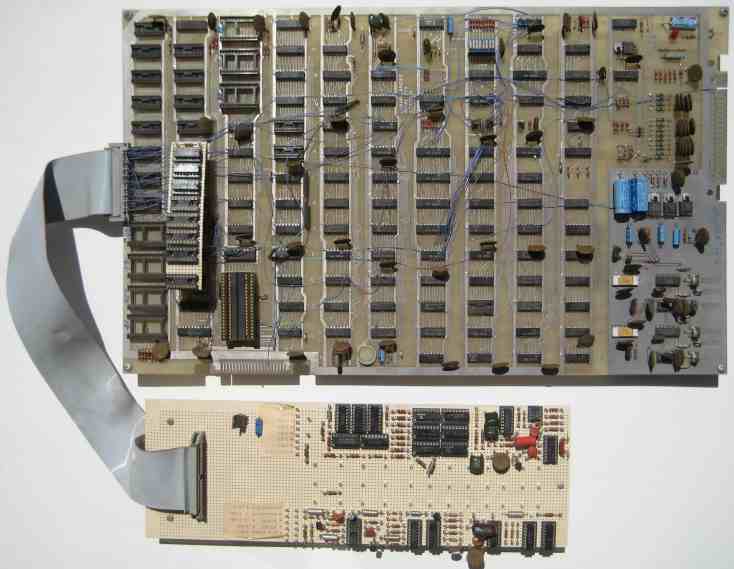
While waiting for his hardware, Logg’s first job was to get the game’s basic concepts down on paper. Here, you can see the original planning document for Asteroids hand written by Logg.
Amazingly, the finished game is almost exactly as he describes it here:
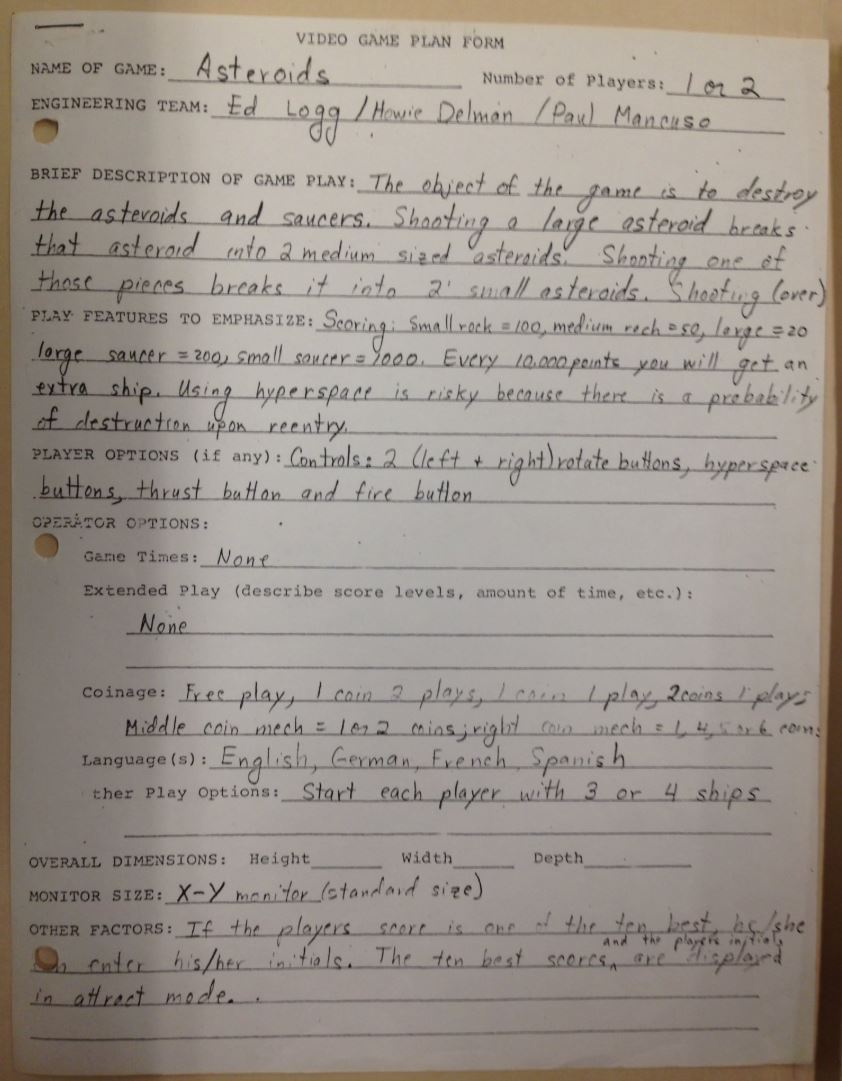
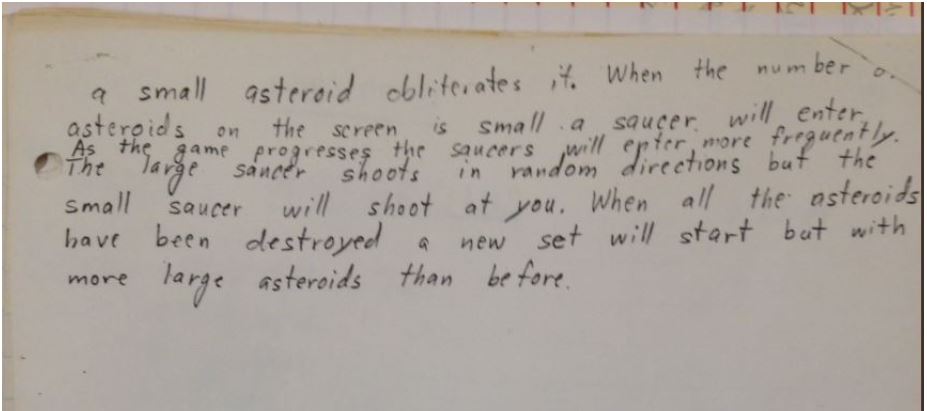
The object of the game is to destroy the asteroids and saucers. Shooting a large asteroid breaks that asteroid into two medium-sized asteroids. Shooting one of those pieces breaks it into two small asteroids.
Another interesting development document can be viewed here.
Logg recalls the intensity of the development process:
I was shooting the asteroids all night long. I’d just play the game over and over and over in my head, just as if you were playing it in real life. To a certain extent, I play a lot of the games in my mind long before I ever write them because you have to get all the interactions down pat before you can start programming. I know what it’s going to look like before I even get there.

When you play Asteroids, it is worth taking a step back and thinking about Logg’s knack for genius design. He tweaked and toyed with the inertia of the player’s ship in an effort to get the play just right – at one point there was no friction to the ship at all which made the game too easy. Another idea was to ramp the friction of the ship’s thrust right up – but this resulted in too many accidental deaths and a feeling that the player wasn’t fully in control of the craft. Settling on the gentle mid-point glide effect of the ship gave players just the right balance between control and danger.
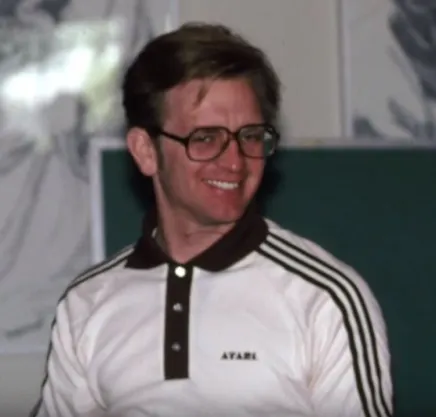
A side-effect of the vector hardware used, also delivered some noticeable features in Asteroids. As well as the simple bleakness of the white on black vectors, Logg makes reference to the glow that follows the player’s ship around the screen, giving the impression of a vapour trail billowing out from behind your ship. This was completely unintentional and nothing more than the phosphor of the ship’s outline taking a split second to cool down on the arcade monitor tube as it moves away from a stationary spot.

The rocks themselves pushed players to create strategies within the game. The Asteroids universe takes place on a single screen, but a wrap-around warp mechanic was employed that meant that anything moving off the edge of the screen, reappeared at the opposite side to continue its path. The only way to deal with the asteroids, was to shoot them. The danger they represented would not simply float away. And so Logg found that early players of his code (usually fellow developers and engineers at the Atari plant) developed different ways of attacking the world. Some would shoot everything they could, and others were more circumspect about handling the floating rocks – either avoiding them altogether, or picking them off and breaking them down one at a time.
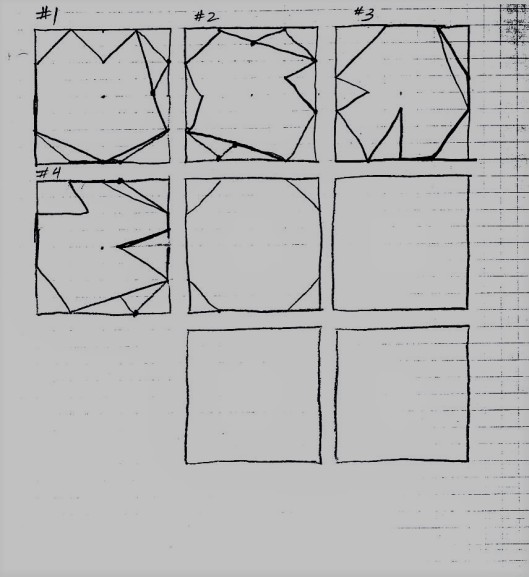
Observing the way his colleagues were approaching his game, Logg decided he had to push the player further to move around the screen and keep shooting.
I wanted to discourage you from not shooting stuff. Get rid of those small rocks so I can send a new lot of bigger rocks out there, because more stuff on-screen means more chance of an unfortunate collision.
Enter the saucers:
Two saucers were developed and dropped into the game – one dumb, one smart. A large lumbering one that fired shots off randomly – handy for dashing player plans for neat Asteroids fields, as shots could easily hit passing rocks – and a smaller saucer – harder to hit, with built-in deadly accuracy with shots aimed at the player’s ship. As described here:
I always wanted two saucers. A big one that fired randomly like cannon fodder to get you used to the concept that when you got down to fewer rocks, a ship was going to come out. The little saucer was about making you move. Run away, you’re going to die if you stick around!
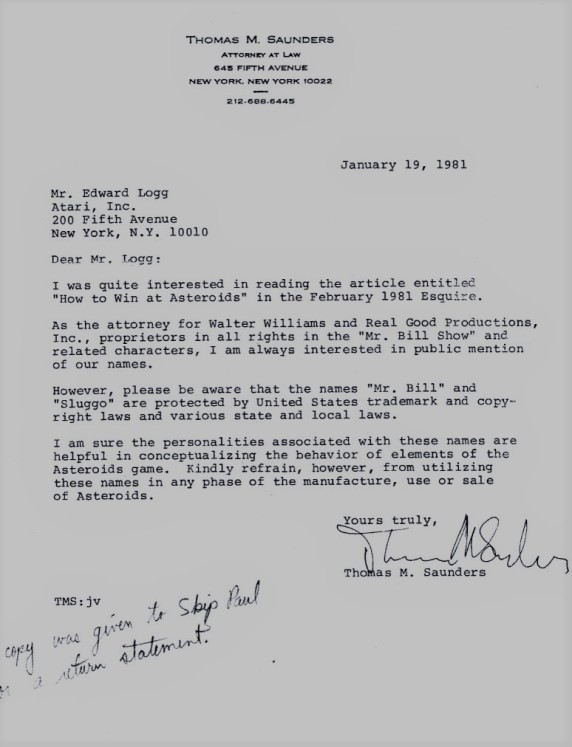
Over the years, Logg has expressed two things that with hindsight, he would change to the final game. The Hyperspace button, and the behaviour of the small saucer:
The Hyperspace button is located some distance away from the other four control buttons. Hitting it will make your ship disappear and reappear a few moments later somewhere else on the screen, with a one in six chance of your ship exploding on re-entry. A neat feature intended to use as a last resort when death is inevitable, but one that many players never use, mainly because of how difficult it is to reach for the button!
The small saucer originally was programmed to shoot directly at the player as soon as it appeared on-screen. Field testing of the game gave feedback that this was unfair, so Logg changed the saucer’s algorithm to miss the player with its first shot, to give a chance to respond. This led to the (in)famous “lurking” tactic used by players to this day, where a single rock can be left on-screen, and players can pick off 1,000 points a time by shooting down saucers as they appear on screen.
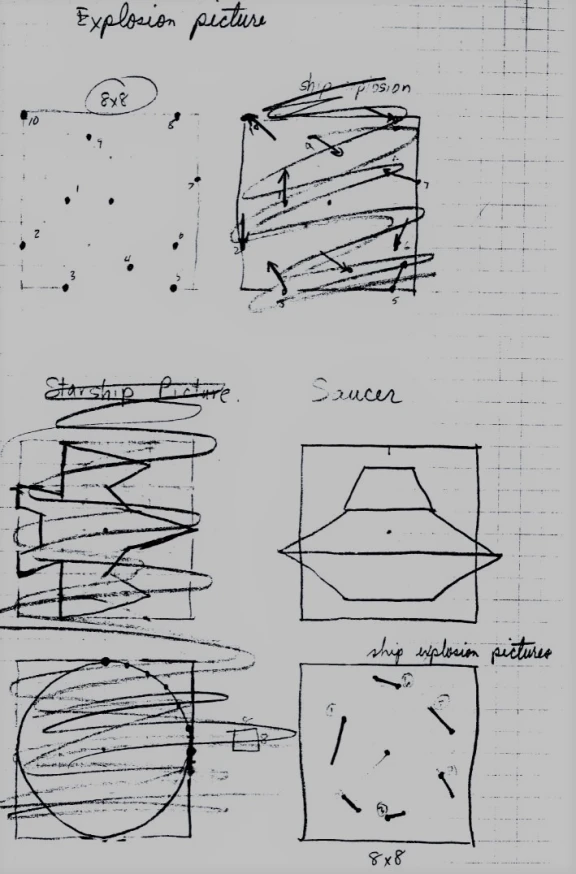
Field Testing was done with two groups of players, both young and old. The feedback was very positive. Take a look here at the original field test report. (Courtesy of Ed Logg). Logg was inspired:
When we field-tested Asteroids for the very first time, I saw a player start a game and die three times; each within 20 seconds. He proceeded to put another quarter in. This tells me the player felt it was his fault he died and he was convinced he could do better. This is one of the primary goals a game designer tries to achieve and it was clear to me Asteroids had it.
More confirmation that the game was going to be a success.
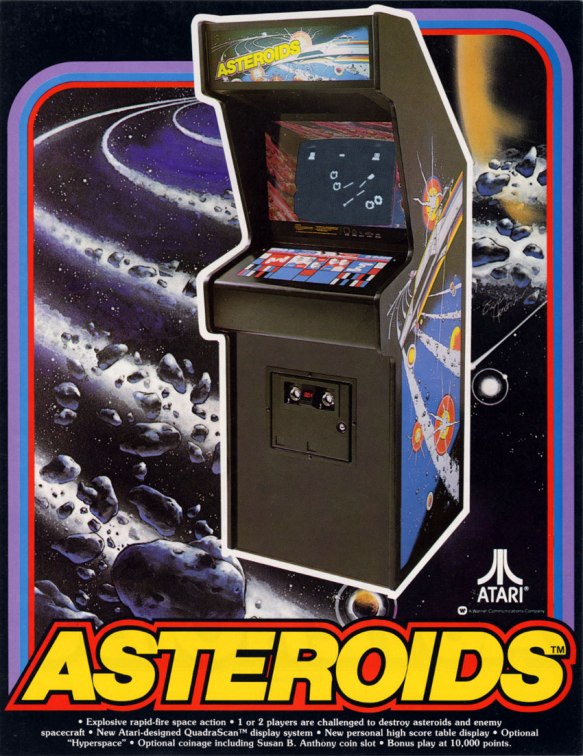
Production started in late 1979. In an interview back in 1981, Mary Takatsuno, a marketing analyst at Atari, gave an interesting insight to the reaction to the game within the company.
Asteroids is the only game that ever stopped production lines in our plant. At break time, the entire assembly line would run over to play the machines that were ready to be shipped out. With other games, the guys would just assemble them and box them up, and that was that. But with Asteroids, nobody wanted to work.
This interesting document details the raw cost to Atari of building an upright cabinet.
Logg knew he had created a hit. The game had a massive impact on Atari’s fortunes. Outselling everything released by Atari to date, Asteroids quickly became part of the furniture not only in arcades, but in other locations too. Bars, airports, shopping malls and waiting rooms. Operators of buildings where large amounts of footfall were present, clamoured for this new game. Reports came in of some machines taking over $1,000 a week in earnings, allowing the capital investment in the game to be repaid in a matter of days.

This huge demand resulted in over 75,000 units being sold – a huge earner for Atari and a huge impact on Pop Culture at the time. Arcade machines had hit the mainstream and were no longer seen as a distraction to male teenagers of the day. Professionals in their 30s and 40s sought out the game in their lunch hours, playing alongside kids and anyone else lured by the vector glow of the game.
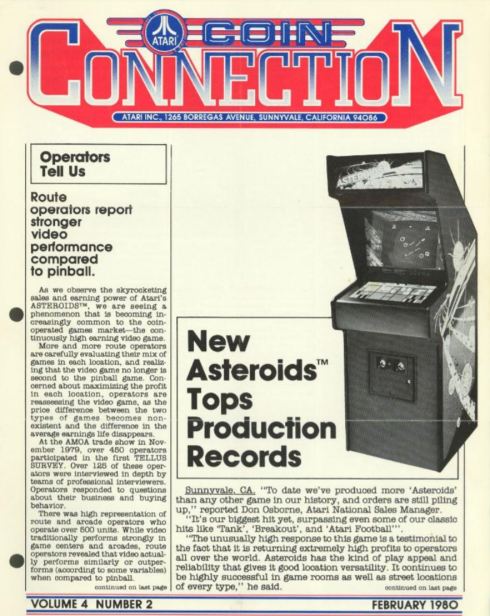
Asteroids drew in players from all walks of life. Including rock royalty. Ronnie James Dio turned out to be a huge fan of the game – his personal cabinet was auctioned off recently following his death. It netted an astonishing $5,120. There’s even footage out there of him and his band-mates playing the game way back when.
The late Don Osbourne, Atari’s Sales Director, stated in 1980, that Asteroids at the height of its popularity “easily took $10 million a week in quarters”, an astonishing statistic if you think about it.
Ultimately, three cabinet types were released, in upright, cabaret and cocktail formats.
The game’s success spawned an inevitable sequel, Asteroids Deluxe. Keeping the original mechanics, Deluxe saw the action sped up, and new features added – it was another huge hit for Atari.

Logg’s legacy at Atari continued with the creation of Centipede and Gauntlet – both huge games in their own rights – but Asteroids was where things really took off. Logg’s uncanny ability to hone gameplay with just the right balance of risk and reward, played into Atari’s mantra of “Easy to learn, difficult to master”, and earned him the nickname “Golden Boy” within the corridors of Atari.
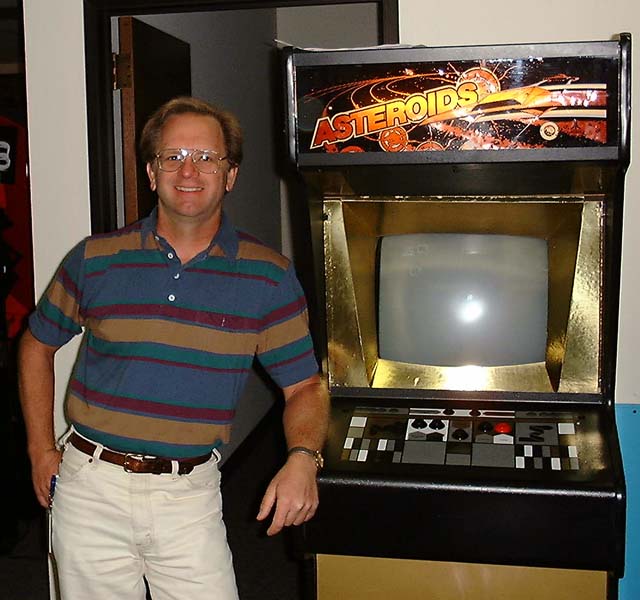
Logg’s uncanny ability to tune gameplay elements to perfection was the secret of his success. As his former Atari Games colleague Mark Cerny put it in 2012:
What I learned from Ed was that creating the fun of a game did not require complex algorithms as much as it required the right approach. Which is to say that it wasn’t virtuoso coding that made Ed’s games a success, as much as it was putting all the proper features in the game in the correct order.

Today, Asteroids remains at the heart of any serious arcade enthusiast’s collection. I own a cabaret version of the game (with a multi-game kit, allowing play of Asteroids, Asteroids Deluxe and Lunar Lander). If you want to read the restoration process I went through, take a look here.
Thanks for reading this week – if you enjoyed this article, please consider sharing a link to this page on your favourtite social media platform.
See you next time.
Tony

What a truly great write up. Fantastic information here Tony with some fabulous original documents and insights.
I should get my hands on my recently acquired cocktail cabinet next month, which won’t work, but will be fun to restore.
LikeLiked by 2 people
Do Lunar Lander!!!
LikeLiked by 2 people
It’s half done actually Phil. Keep an eye out!
LikeLike
So great to read a fine treatment of these vector games I loved to play as a kid. Another one which I’ve hardly seen mentioned (after battle zone? Green tanks) is a ww1 aircraft vector game – I can’t remember if it was tail gunner or red baron….
LikeLiked by 2 people
What a great write-up Tony! I played Asteroids at Fun Spot (thanks to your suggestion!) a few weeks ago and can attest to just how amazing that phosphor glow is on the game. It is amazing how I played that decades ago and only now realize just how enchanting the vector monitor makes these games. The shots nearly jump off the screen, they are so bright.
LikeLiked by 4 people
@John – Both Red Baron and Tail Gunner were vector games, but Red Baron would be the WW 1 game you would be thinking of.
LikeLiked by 2 people
Tony,
Great write up!
Mike
LikeLiked by 3 people
I have to say, the ‘cabaret’ version of the game that you have sounds intriguing!
LikeLiked by 2 people
I love that they had a form you had to fill out for a game proposal that was only big enough to be considered an entry level French language quiz. Classic.
LikeLiked by 3 people
The popping in another quarter after losing 3 lives in the first minute is so true. When I played it for the very first time, I had no idea how the game worked, but eventually got the hang of it. Thanks for the trip down memory lane.
LikeLiked by 2 people
This might be the most nostalgic blog I’ve ever read. It takes me back to my first kiss (I meant Quarter, same dif…). Thank you!!!
LikeLiked by 3 people
Those documents and sketches! Would love to see side 2 of the original design sheet. Note it says ‘over’ on the right hand side.
LikeLiked by 3 people
Flinnster, I have it. Will add it to the article when I get a minute.
LikeLiked by 2 people
Your blog appeared on my WordPress Reader this morning so I started to read it and became fascinated. I had Seinfeld on in the background and, ironically, it was the episode “The Frogger!”
LikeLiked by 3 people
I always thought the artwork on the cab,looked a bit like cylon raiders from the original battlestar galactica,not sure if this was intentional or not
LikeLiked by 1 person
GREAT writeup, however, why is there no mention of the cabaret series 2 player machine (which I am a very proud owner of one.
LikeLiked by 1 person
A two player cabaret? Tell us more!
LikeLike
you got it… it is a sit at table (with monitor under the tabletop glass) opponents sit facing each other, (game switches around for each player).. currently mine needs a re-cap (Replacement capacitors in the power supply) but has been in my possession for some 22 years now, and just recently when I went to power it up, did I find it now had small isues).
LikeLiked by 1 person
Ah – a cocktail table. Yeah they are nice things to work on Greg. I like the wood grain on those.
LikeLike
Just looked at what you call a cabaret version, assuming you are correct, that would make my version a cocktail version (table version) I had included a picture of mine in my last post……
LikeLiked by 1 person